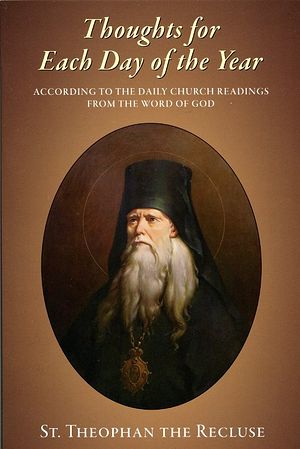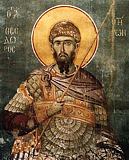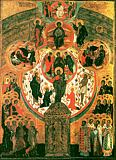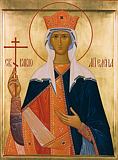

| Previous day | Next day |
| Old Style
March 6
|
Saturday |
New Style
March 19
|
|
1st Week of Great Lent.
Tone 8.
Великий пост. |
Wine and oil allowed.
|
![]() The 42 Martyrs of Ammorium in Phrygia, including Constantine, Aetius, Theophilus, Theodore, Melissenus, Callistus, Basoes, and others (ca. 845). St. Job ( Joshua in schema) of Anzersk Island (Solovki) (1720).
The 42 Martyrs of Ammorium in Phrygia, including Constantine, Aetius, Theophilus, Theodore, Melissenus, Callistus, Basoes, and others (ca. 845). St. Job ( Joshua in schema) of Anzersk Island (Solovki) (1720).
Monk-martyrs Conon and his son Conon, of Iconium (270-275). The uncovering of the Precious Cross and the Precious Nails by Empress St. Helen (326). St. Arcadius, monk, of Cyprus (4th c.) and his disciples Julian and Bulius.
Icons of the Most Holy Theotokos: “Chenstokhov” (Poland) (1st c.) and “Blessed Heaven” (Moscow) (14th c.).
Martyrs Cyriacus and 12 companions, who suffered under Diocletian in Augsburg (ca. 304) St. Fridolin, abbot, enlightener of the Upper Rhine (5th c.-6th c.).
Repose of Helen Kontzevitch, Church writer (1989).
Thoughts for Each Day of the Year
According to the Daily Church Readings from the Word of God
By St. Theophan the Recluse

Saturday. [Heb. 1:1–12; Mark 2:23–3:5]
We have approached the chalice of the Lord, we have been at the Supper of the Lord. Glory to Thee, O God! Glory to Thee, O God! Glory to Thee, O God! Now is the great day of the Lord! The most glorious celebration in heaven! There is no city, nor village, nor house, where there are no people receiving Holy Communion. Across the breadth of Russia, throughout the south and east, so many people clothed in the white garments of justification have tasted of the Divine life, and have most sincerely united themselves with the Lord! The Lord’s Body has been renewed—the Body of the Church, and has been clothed in the glory belonging to it, hidden from the eyes of man, but visible to the eyes of angels. The angels worshipped the First-born when He was brought to the world in His power; now they have worshipped Him because the world has been brought again to Him. They have worshipped Him and sung out: Thy throne, O God, is for ever and ever: the sceptre of Thy kingdom is a right sceptre; Thou lovest righteousness, and hatest wickedness (Ps. 45:6–7).


